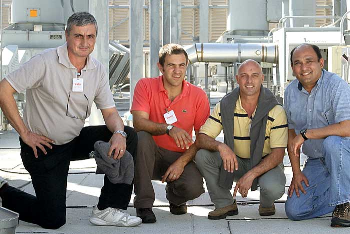
Argentine engineers Ruben Fassio, from left, Ernesto Cascardo and Daniel Franco Ciani, join Miguel Grimaldo, director of UTMB Biological Containment.
Buenos Aires, Argentina, and Galveston are separated by 4,977 miles as the crow flies.
But the long trip was more than worth it for a trio of Argentines who recently received specialized training in biocontainment at the Galveston National Laboratory at UTMB.
“It was more than just the training,” Ruben Fassio said. “It was so much more than we expected or hoped for.”
Fassio is an engineer at the research laboratory and vaccine production facility Instituto Nacional de Enfermedades Virales Humanas “Dr. Julio Maiztegui” in Pergamino, about a three-hour drive from Buenos Aires.
He came with fellow engineer Ernesto Cascardo and Daniel Franco Ciani, an engineer with Universidad Tecnologica Nacional in Buenos Aires. They traveled to the medical branch for a unique training program at the National Biocontainment Training Center.
The lab was established in 2009 with funding from the U.S. Department of Defense and developed to train people to work safely in biosafety level two, three and four laboratories, often referred to as BSL-2, BSL-3 or BSL-4 labs. This training extends to both scientists who work in the labs and to engineers who run these facilities.
The training facilities at the medical branch include the Robert E. Shope, M.D. Laboratory, the first full-suit BSL-4 laboratory on a U.S. academic campus, as well as the Galveston National Laboratory, one of only two national biocontainment laboratories built with funding awarded by the National Institutes of Health in response to the federal government’s call to expand the nation’s infectious disease research infrastructure.
While national is in the lab’s name, the program always has considered international outreach a part of its mission.
About 70 scientists from 21 countries have trained at the center, learning how to safely perform research in one of these restricted laboratories. The Argentines are the first international visitors to train in the engineering, operational and safety aspects of these highly specialized laboratory environments, focusing on how to keep labs running safely and securely while studying viruses that can be deadly and contagious.
The training was the result of a long, working relationship between Dr. James LeDuc, director of the lab, and Dr. Delia Enria, director of the Pergamino laboratory and a world expert on Argentine hemorrhagic fever.
“Dr. Enria and I both have a primary responsibility to ensure that the work done in our laboratories is first and foremost safe for our staff and safe for our surrounding communities,” LeDuc said.
“This starts with having well-trained building engineers who understand the complex workings of the facilities and who use established best practices to guarantee their safe and secure operations. The NBTC allows us to share these best practices and to learn from the experiences of others. It’s clearly a win-win situation.”
As the only operational full-suit BSL-4 laboratories on a university campus in the United States, the lab and the Robert E. Shope Laboratory provide a critical resource for basic and applied research designed to diagnose, prevent and treat diseases caused by some of the world’s most dangerous pathogens.
The world of these high-end labs is small and the expertise it takes to run one requires apprenticeship of sorts. Take what you know about the complexities involved in typical building engineering — now add in killer viruses, a state-of-the-art air flow and filtration design, advanced decontamination procedures, heightened security and extensive testing requirements and you begin to understand the world of a biocontainment engineer.
“There are no degrees granted in exactly what we do,” said Miguel Grimaldo, the medical branch’s biological containment director and one of the experts in this rare world. “Expertise in biocontainment engineering comes from great mentors and lifelong learning.”
He’s pleased to share what he’s learned with those who work in the field.
“I want people to know how to do this safely and securely,” he said.
Grimaldo said the research done in these laboratories might benefit the health of all humanity.
The group spent 10 days touring the various laboratories, learning best practices and solving problems they’ve encountered at home. They are taking a wealth of knowledge, legally vetted for export, back to Argentina to improve their laboratories.
“After my time here, I know what I’m doing right and where we need to make improvements,” Fassio said. “Moving forward, I know the right way to do things and can train others the right way.”
That shared expertise represents one of the medical branch’s core values and encapsulates the goals of this unique program.